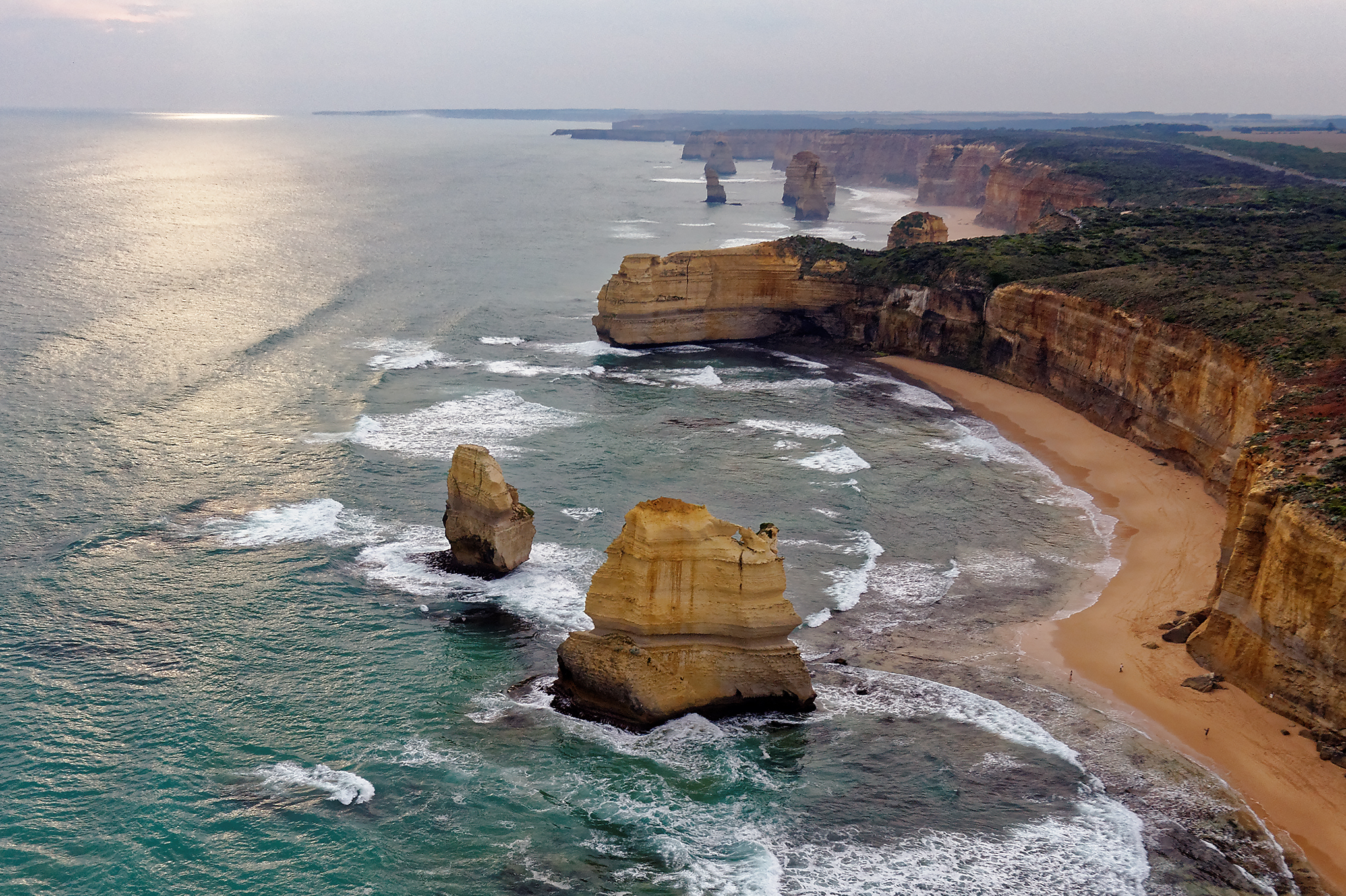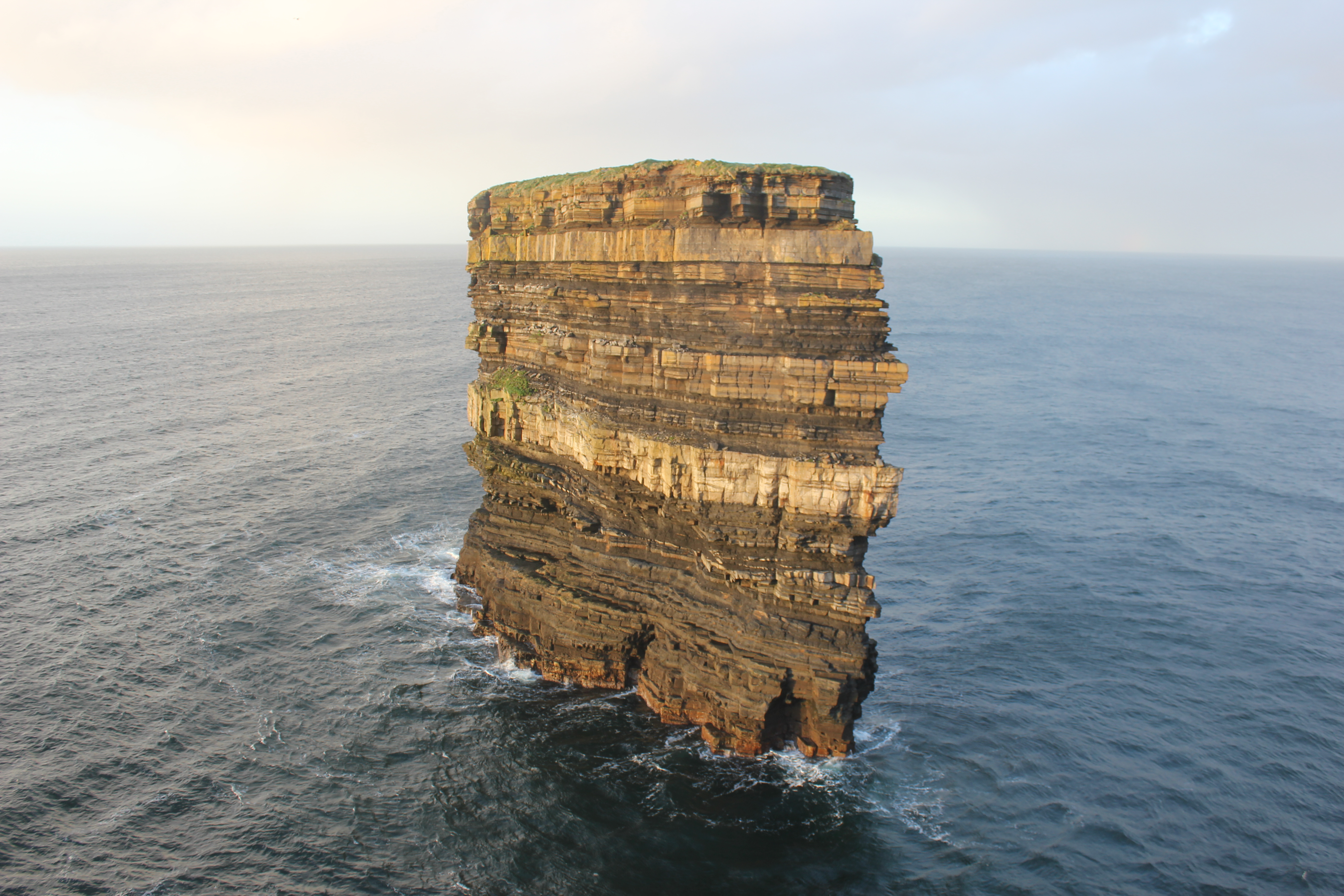Stack (geology) on:
[Wikipedia]
[Google]
[Amazon]
 A stack or sea stack is a
A stack or sea stack is a "Sea stacks"
britannica.com They are formed when part of a
 Stacks typically form in horizontally bedded
Stacks typically form in horizontally bedded
 A stack or sea stack is a
A stack or sea stack is a geological
Geology (). is a branch of natural science concerned with the Earth and other astronomical objects, the rocks of which they are composed, and the processes by which they change over time. Modern geology significantly overlaps all other Earth s ...
landform
A landform is a land feature on the solid surface of the Earth or other planetary body. They may be natural or may be anthropogenic (caused or influenced by human activity). Landforms together make up a given terrain, and their arrangement ...
consisting of a steep and often vertical column or columns of rock in the sea near a coast, formed by wave erosion. Stacks are formed over time by wind and water, processes of coastal geomorphology.britannica.com They are formed when part of a
headland
A headland, also known as a head, is a coastal landform, a point of land usually high and often with a sheer drop, that extends into a body of water. It is a type of promontory. A headland of considerable size often is called a cape.Whittow, Jo ...
is eroded by hydraulic action, which is the force of the sea or water crashing against the rock. The force of the water weakens cracks in the headland, causing them to later collapse, forming free-standing stacks and even a small island. Without the constant presence of water, stacks also form when a natural arch collapses under gravity
In physics, gravity (), also known as gravitation or a gravitational interaction, is a fundamental interaction, a mutual attraction between all massive particles. On Earth, gravity takes a slightly different meaning: the observed force b ...
, due to sub-aerial processes like wind erosion. Erosion causes the arch to collapse, leaving the pillar of hard rock standing away from the coast—the stack. Eventually, erosion will cause the stack to collapse, leaving a stump. Stacks can provide important nesting locations for seabird
Seabirds (also known as marine birds) are birds that are adaptation, adapted to life within the marine ecosystem, marine environment. While seabirds vary greatly in lifestyle, behaviour and physiology, they often exhibit striking convergent ...
s, and many are popular for rock climbing
Rock climbing is a climbing sports discipline that involves ascending climbing routes, routes consisting of natural rock in an outdoor environment, or on artificial resin climbing walls in a mostly indoor environment. Routes are documented in c ...
.
Isolated steep-sided, rocky oceanic islets typically of volcanic origin, are also loosely called "stacks" or "volcanic stacks".
Formation
 Stacks typically form in horizontally bedded
Stacks typically form in horizontally bedded sedimentary
Sedimentary rocks are types of rock formed by the cementation of sediments—i.e. particles made of minerals (geological detritus) or organic matter (biological detritus)—that have been accumulated or deposited at Earth's surface. Sedime ...
or volcanic rock
Volcanic rocks (often shortened to volcanics in scientific contexts) are rocks formed from lava erupted from a volcano. Like all rock types, the concept of volcanic rock is artificial, and in nature volcanic rocks grade into hypabyssal and me ...
s, particularly on limestone
Limestone is a type of carbonate rock, carbonate sedimentary rock which is the main source of the material Lime (material), lime. It is composed mostly of the minerals calcite and aragonite, which are different Polymorphism (materials science) ...
cliffs. The medium hardness of these rocks means medium resistance to abrasive and attritive erosion
Erosion is the action of surface processes (such as Surface runoff, water flow or wind) that removes soil, Rock (geology), rock, or dissolved material from one location on the Earth's crust#Crust, Earth's crust and then sediment transport, tran ...
. A more resistant layer may form a capstone. (Cliffs with weaker rock, such as claystone or highly jointed rock, tend to slump and erode too quickly to form stacks, while harder rocks such as granite
Granite ( ) is a coarse-grained (phanerite, phaneritic) intrusive rock, intrusive igneous rock composed mostly of quartz, alkali feldspar, and plagioclase. It forms from magma with a high content of silica and alkali metal oxides that slowly coo ...
erode in different ways.)
The formation process usually begins when the sea attacks lines of weakness, such as steep joints
A joint or articulation (or articular surface) is the connection made between bones, ossicles, or other hard structures in the body which link an animal's skeletal system into a functional whole.Saladin, Ken. Anatomy & Physiology. 7th ed. McGraw- ...
or small fault zones in a cliff face. These cracks then gradually get larger and turn into caves. If a cave wears through a headland, an arch forms. Further erosion causes the arch to collapse, leaving the pillar of hard rock standing away from the coast, the stack. Eventually, erosion will cause the stack to collapse, leaving a stump. This stump usually forms a small rock island, low enough for a high tide to submerge.
See also
*Ball's Pyramid
Ball's Pyramid is an uninhabited islet in the Pacific Ocean located southeast of Lord Howe Island, between Australia and New Zealand. The steep rocky basalt outcrop is the eroded plug of a shield volcano and caldera that formed 6.4million ye ...
, the tallest sea stack in the world
* List of sea stacks
* Rauk
References
External links
* {{coastal geography Coastal and oceanic landforms Coastal geography